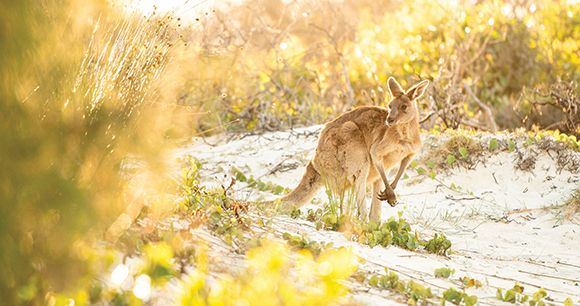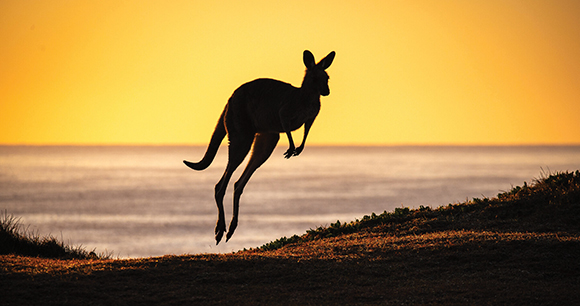by Dennis Vink, Campaign Manager, Kangaroos Alive
I don’t know what shocked me more when I was offered the chance to become a kangaroo advocate in Europe. Was it that I, a native of the Netherlands, had never heard of the kangaroo industry despite considering myself to be relatively aware of animal welfare issues, or that almost none of the corporate leaders, politicians, or friends I reached out to in Europe were aware of it, either? This was alarming, considering that the commercial killing of kangaroos is the world’s largest slaughter of land-based wildlife, with Europe being the main importer of kangaroo products, responsible for 65 percent of the trade. Fortunately, awareness is on the rise in Europe and elsewhere—the global campaign to save kangaroos is building and looking increasingly (I apologize) “hopful.”

Background
Every year, Australian state governments set quotas authorizing the killing of about 5 million wild kangaroos by the commercial kangaroo industry. Their flesh is sold globally as pet food and exotic game meat, while their skins are used to produce high-end soccer shoes, motorcycle gear, hats, wallets, and key rings. The killing occurs under the cover of darkness in remote areas, and there is no supervision or government monitoring of the slaughter. Independent studies have revealed that up to 40 percent of kangaroos are mis-shot, often leading to prolonged suffering.
One-third of commercially killed kangaroos are female, and an estimated 400,000 healthy baby kangaroos (joeys) suffer collateral deaths when their mothers are killed. The Australian government’s Code of Practice for “humanely” killing kangaroos for profit authorizes shooters to bludgeon the joeys to death. In practice however, hunters rarely make the effort to locate the orphaned joeys and instead leave them to die slowly and alone of starvation or predation.
Meanwhile, nobody knows how many kangaroos are left in the wild. Federal and state governments in Australia claim overabundance, but a New South Wales parliamentary inquiry in 2021 revealed that the methods used to estimate population abundance (on which kill quotas are based) are unreliable and demonstrably lead to biologically impossible outcomes. To cite just one of many examples: Even in a favorable year, the growth rate for these slowly reproducing, nonmigratory marsupials is only about 15 percent, yet the NSW government claimed an increase of 426 percent in a kangaroo management zone in 2015.
The inquiry also highlighted reports of local extinctions and outlined the threat of climate change to kangaroo populations. Ultimately, however, nearly all of the 23 recommendations that emerged from the inquiry have been ignored by the NSW government, including an urgent request to undertake an independent review into the methods used to count kangaroos. Experts have urged the federal and state governments to apply the precautionary principle and halt the commercial slaughter—pleas that have been in vain.
Kangaroos Alive
Following the 2018 release of Kate Clere and Mick McIntyre’s award-winning investigative documentary Kangaroo: A Love-Hate Story, they co-founded Kangaroos Alive as a global movement for the ethical treatment of kangaroos. Nationally and internationally, through political, corporate, and public awareness campaigns, Kangaroos Alive is building support for a moratorium on the commercial killing of kangaroos. In 2020, the organization created World Kangaroo Day, observed annually on October 24, as a day to celebrate and promote protection of kangaroos. Kangaroos Alive partners with Back to Country, a Yuin Nation Aboriginal cultural organization. The Yuin Declaration for Kangaroos, issued in 2021 and authored by the late Yuin Elder Uncle Max Harrison, powerfully affirms the sentience, totemic value, and sovereign rights of kangaroos and underlies the work of Kangaroos Alive.
How do Australians feel about this issue?
In 2023, Kangaroos Alive commissioned an independent, nationally representative survey of 2,000 Australians to assess their attitudes about kangaroos and how they are managed in response to questions from members of the European Parliament.
The survey revealed overwhelming support for kangaroo protection among Australians: 69 percent think the commercial killing of kangaroos causes unnecessary cruelty, and 64 percent think Australia should take a stance against it. Three in four Australians find the killing of joeys unacceptable and inhumane. Fully 98 percent of those surveyed indicated it is important to protect these native grazers in order to protect the wider Australian ecosystems of which kangaroos are a crucial part. The survey found 70 percent support for stopping the commercial slaughter at least until reliable population estimates are available, while 67 percent say that the killing should be stopped until the impact of climate change on kangaroos can be fully assessed. In other words, the commercial kangaroo-killing industry does not have a social license to operate.
Global outrage, global action
These important results only confirm what is evident globally. As more animal protection organizations join the campaign to save kangaroos, we are seeing an exponential increase in worldwide awareness of the cruel slaughter and, in turn, increased pressure on governments to stop fueling this wildlife trade. In 1971, California banned the import of all kangaroo products. In 2012, Russia banned the import of kangaroo meat because of unacceptable bacterial contamination. In 2022, a motion was passed in the Netherlands calling on the government to address the import of controversial kangaroo products into the European Union. And, at present, bills to ban kangaroo products have been proposed in Italy, the Belgian region of Flanders, and the US states of Arizona, Connecticut, New Jersey, Oregon, and Vermont. Policymakers can rest assured that this is what Australians want, as our survey revealed that two-thirds of Aussies want other countries to stop trading kangaroo body parts.
Corporate victories
Corporations worldwide are ditching kangaroo products. Fashion empires Chanel, Diadora, Gucci, H&M, Prada, and Versace all banned the use of kangaroo skins. European supermarket giants Aldi, Carrefour, Delhaize, Makro, and Spar took kangaroo meat off the shelves. The Netherlands saw storied ice skate brand Viking, e-commerce giant Bol, and over 60 other companies pledge to end the sales of kangaroo-derived products. Most recently, pet food giant Purina announced it had discontinued all products containing kangaroo due to animal welfare concerns.
This year, New Balance, Nike, and PUMA pledged to stop using kangaroo skins in their soccer cleats. Adidas stubbornly refuses, thus far, to follow their competitors’ example, but we are confident that persistent and increasing public pressure will eventually prevail. Again, it’s what Aussies want: Our survey revealed that 64 percent want commercial corporations to stop trading in kangaroo body parts, compared to just 13 percent who don’t.
Coexisting with kangaroos
In the period following European settlement of Australia, an apparent inability or lack of desire on the part of many settlers to coexist with wildlife gave rise to this cruel industry. World Kangaroo Day 2023, themed “Coexisting with Kangaroos,” marked the kick-off of the exciting Kangaroo Coexistence Project. The aim of this community-driven effort is to compile an extensive resource with practical guides and information to inspire and enable farmers and landholders to stop the slaughter of kangaroos on their property, and instead switch to nonlethal coexistence methods. This project builds on the knowledge of scientists, Aboriginal leaders, and a large variety of nature-inclusive farmers who are taking the lead in the coexistence movement.
Furthermore, our new Kangaroo Walks & Talks program is now ready for an Australia-wide rollout after a successful pilot effort. This new “kangaroo watching” program, modeled after Australia’s shift from whaling to whale watching, recognizes the importance of the kangaroo—Australia’s most iconic wild animal—to the nation’s $60 billion/year tourism industry. We proudly developed this program in close collaboration with our partner, Back to Country.
Our survey confirmed that Australians support this coexistence approach. A striking majority of Australians want kangaroos to remain part of the Australian landscape (90%) and think we should share the land with them (88%). Australians feel kangaroos deserve a fair share of grazing on their native land (80%) and support switching to nonlethal coexistence practices (69%). Over three-quarters of Australians (78%) think it is important to examine the potential economic benefits of kangaroo ecotourism versus the purported benefits of the commercial killing of kangaroos.

The industry will fall
Australia’s kangaroo-killing industry is clearly terrified, as evidenced by their delegations of lobbyists and corporate shills dispatched to Europe and the United States to defend the slaughter, as well as their recent rebranding efforts. They can no longer ignore the mounting global pressure and are well aware that they lack both future prospects and current social license.
Despite the slow pace inherent in complex and multifaceted campaigns like these, we sense the industry’s imminent downfall, and they do too. The day will come when people visiting Australia will only encounter kangaroos in their natural habitat, happily hopping with their mob (as a group of kangaroos is called), and no one anywhere will encounter them as body parts on store shelves. Until then, we and our partner organizations worldwide will tirelessly continue to push for the protection that kangaroos deserve.